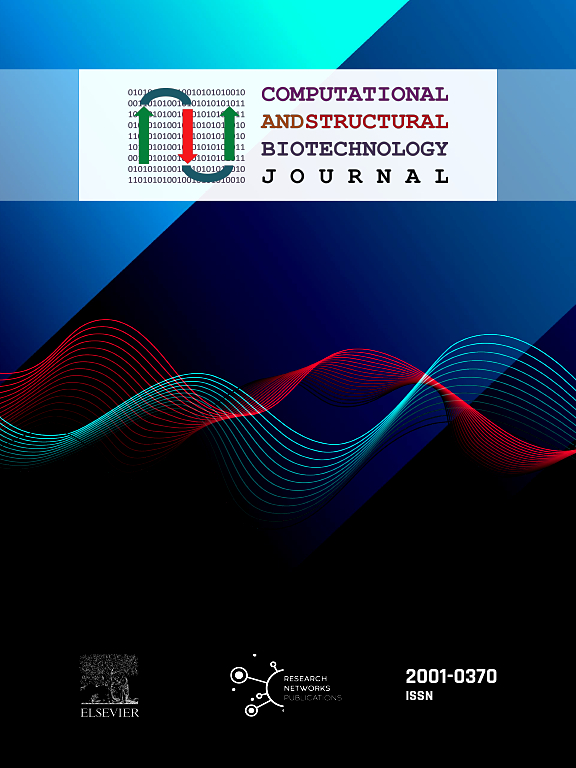Predicting pathogen evolution and immune evasion in the age of artificial intelligence
IF 4.4
2区 生物学
Q2 BIOCHEMISTRY & MOLECULAR BIOLOGY
Computational and structural biotechnology journal
Pub Date : 2025-01-01
DOI:10.1016/j.csbj.2025.03.044
引用次数: 0
Abstract
The genomic diversification of viral pathogens during viral epidemics and pandemics represents a major adaptive route for infectious agents to circumvent therapeutic and public health initiatives. Historically, strategies to address viral evolution have relied on responding to emerging variants after their detection, leading to delays in effective public health responses. Because of this, a long-standing yet challenging objective has been to forecast viral evolution by predicting potentially harmful viral mutations prior to their emergence. The promises of artificial intelligence (AI) coupled with the exponential growth of viral data collection infrastructures spurred by the COVID-19 pandemic, have resulted in a research ecosystem highly conducive to this objective. Due to the COVID-19 pandemic accelerating the development of pandemic mitigation and preparedness strategies, many of the methods discussed here were designed in the context of SARS-CoV-2 evolution. However, most of these pipelines were intentionally designed to be adaptable across RNA viruses, with several strategies already applied to multiple viral species. In this review, we explore recent breakthroughs that have facilitated the forecasting of viral evolution in the context of an ongoing pandemic, with particular emphasis on deep learning architectures, including the promising potential of language models (LM). The approaches discussed here employ strategies that leverage genomic, epidemiologic, immunologic and biological information.

预测人工智能时代的病原体进化和免疫逃逸
在病毒流行和大流行期间,病毒病原体的基因组多样化是感染因子规避治疗和公共卫生举措的主要适应途径。从历史上看,应对病毒进化的战略依赖于在发现新出现的变异后作出反应,导致有效的公共卫生反应延迟。正因为如此,一个长期存在但具有挑战性的目标是通过在病毒出现之前预测潜在有害的病毒突变来预测病毒的进化。人工智能(AI)的前景,加上COVID-19大流行推动的病毒数据收集基础设施的指数级增长,形成了一个非常有利于实现这一目标的研究生态系统。由于COVID-19大流行加速了大流行缓解和防范策略的制定,因此本文讨论的许多方法都是在SARS-CoV-2进化的背景下设计的。然而,大多数这些管道都是有意设计成适应RNA病毒的,有几种策略已经应用于多种病毒物种。在这篇综述中,我们探讨了最近在持续大流行背景下促进病毒进化预测的突破,特别强调了深度学习架构,包括语言模型(LM)的潜力。这里讨论的方法采用利用基因组学、流行病学、免疫学和生物学信息的策略。
本文章由计算机程序翻译,如有差异,请以英文原文为准。
求助全文
约1分钟内获得全文
求助全文
来源期刊

Computational and structural biotechnology journal
Biochemistry, Genetics and Molecular Biology-Biophysics
CiteScore
9.30
自引率
3.30%
发文量
540
审稿时长
6 weeks
期刊介绍:
Computational and Structural Biotechnology Journal (CSBJ) is an online gold open access journal publishing research articles and reviews after full peer review. All articles are published, without barriers to access, immediately upon acceptance. The journal places a strong emphasis on functional and mechanistic understanding of how molecular components in a biological process work together through the application of computational methods. Structural data may provide such insights, but they are not a pre-requisite for publication in the journal. Specific areas of interest include, but are not limited to:
Structure and function of proteins, nucleic acids and other macromolecules
Structure and function of multi-component complexes
Protein folding, processing and degradation
Enzymology
Computational and structural studies of plant systems
Microbial Informatics
Genomics
Proteomics
Metabolomics
Algorithms and Hypothesis in Bioinformatics
Mathematical and Theoretical Biology
Computational Chemistry and Drug Discovery
Microscopy and Molecular Imaging
Nanotechnology
Systems and Synthetic Biology
 求助内容:
求助内容: 应助结果提醒方式:
应助结果提醒方式:


